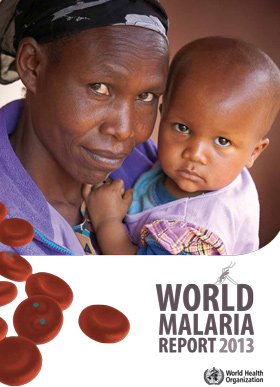Despite gains, recent financial shortfalls and delays in the delivery of commodities have slowed progress, demonstrating the fragility of past success, according to findings of the World Health Organization’s World Malaria Report 2013.

New York, NY: The World Health Organization’s World Malaria Report 2013, released today, notes continued progress to significantly reduce malaria cases and deaths. But the report also documents that financial shortfalls in 2011 and 2012 led to reductions in lifesaving commodities that have slowed progress.
Among the most important findings, the fight against malaria has reduced the malaria mortality rate in children under five by 50% and has saved more than 3.3 million lives in total since 2000, and especially tied to the funding and execution boost received after a peak in malaria cases in 2005. Children’s deaths averted through malaria efforts account for 20% of all child deaths averted through global efforts since 2000, indicating the outsized impact that malaria interventions have had in helping achieve Millennium Development Goal 4, which is to reduce by two thirds, the under-5 mortality rate between 1990 and 2015.
“Investments in malaria control, mostly since 2007, have paid off tremendously. More than 3 million children are alive today as a result. There is simply no greater return on investment than those lives saved,” said Ray Chambers, the UN Secretary-General’s Special Envoy for Financing the Health Millennium Development Goals and for Malaria. “At the same time we have also seen the funding cutbacks of 2011-2012 translate directly into a flattening in the curve of the decline, reminding us that given a chance this disease can relentlessly rear back, which we cannot allow to happen.”
As documented in the WHO report, child deaths have fallen to fewer than 500,000 in 2012, the last year for which data are available. The report suggests, conservatively, that if we were to maintain the annual rate of decrease that has occurred over the past 12 years, by 2015 we will achieve a 63% decline in malaria mortality for children under the age of five, from the 2000 baseline. This by itself would be a remarkable achievement.
Providing room for even greater hope, in November 2013, The Global Fund to Fight AIDS, Tuberculosis and Malaria — in partnership with UNICEF, the UK’s Department for International Development, and the U.S. President’s Malaria Initiative — orchestrated the single largest mosquito net tender in history, in which over 200 million nets are being set for distribution over the next 12-to-18 months. This unprecedented number of additional nets should result in the highest coverage ever achieved, replacing 120 million existing nets and providing 80 million additional nets, covering 160 million additional people.
“The good news is that now, thanks to the collaboration of all key partners, we have a genuine chance to achieve fewer than 100,000 deaths from malaria by the end of 2015,” said Special Envoy Chambers. “These efforts are not only helping families thrive but we are adding tens of billions of dollars to economies, primarily in Africa, that nations can now use in other ways, including attracting increased foreign investment.”
In addition to this massive increase in net distribution, the provision of Artemisinin-based Combination Therapies (ACTs), through both public and private-sector outlets, has the potential to increase, as does the provision of malaria rapid diagnostic tests (RDTs) so that ACTs are given to those who will benefit from them. The impact of improved malaria case management should begin to register more evidently in future mortality estimates.
In 2008 Secretary-General Ban Ki-moon established the goal of reducing malaria deaths among children to “near-zero”, which we define as less than 100,000 child deaths annually. Since then, $5 billion has been mobilized, and nearly 500 million insecticide treated nets and hundreds of millions of diagnostic testing and courses of treatment have been delivered to sub-Saharan Africa, where 90% of deaths occur.
Combating malaria is critical to achieving the Millennium Development Goal on Child Mortality – MDG 4. While fewer children are dying from malaria than ever before, we must remain vigilant and not allow complacency to take hold while we end child deaths, and lay the foundation for a malaria free future.

